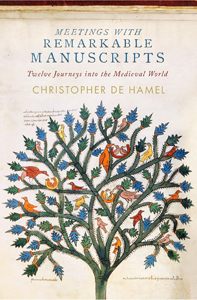 Christopher de Hamel, Meetings with Remarkable Manuscripts (New York: Penguin, 2016), 632pp.
Christopher de Hamel, Meetings with Remarkable Manuscripts (New York: Penguin, 2016), 632pp.
"This is a book about visiting important medieval manuscripts," writes Christopher de Hamel, "and what they tell us and why they matter." Unlike much art that we can enjoy in museums, for the vast majority of us, such historical treasures are totally inaccessible, behind lock and key in rare book rooms, and under the custody of imperious librarians. They are far too valuable and fragile for mere mortals to handle.
De Hamel's magisterial volume of meticulous scholarship does the next best thing. He explores the fascinating "biographies" and controversial histories of twelve "celebrity" manuscripts that date from the sixth to the sixteenth centuries. The book includes over 200 pages of illustrations. His lineup includes not just gospel and prayer books, but also a text of astronomy, commentaries on Revelation and Isaiah, music, literature, and Renaissance warfare. Some of these books are downright dainty, whereas the 2000-page Codex Amiatinus weighs in at 75 pounds and required 515 calf skins to produce. The Book of Kells is arguably "the most famous book in the world."
If there is a "single theme" here, de Hamel says it is the sheer joy and pleasure of appreciating these manuscripts that are a combination of so many things: literary text, artistic treasure, detective stories about their provenance, history, faith, and the "element of pure chance" in their very survival. We might not share the faith and piety that's reflected in them, but they nonetheless provide what he calls an "utterly captivating experience." They have "the power to gladden the heart and bring the distant past very vividly to heart."
In his epilogue de Hamel describes how as a teenager he became "entranced" with the medieval manuscripts that he encountered in the Dunedin Public Library at the southern end of New Zealand: "The staff allowed me to take them out of their cases and I used to spend whole Saturdays turning pages with wonder and enchantment." After completing his doctorate at Oxford, de Hamel spent a distinguished twenty-five years at Sotheby's in New York in their Western Manuscript Department (1975–2000). In 2000 he was elected as the Donnelley Fellow Librarian of Corpus Christi College at Cambridge University. He is perhaps the best-known "paleographer" in the world, having catalogued more illuminated manuscripts than any other person alive, and very possibly more than any one individual has ever done.
Dan Clendenin: dan@journeywithjesus.net


